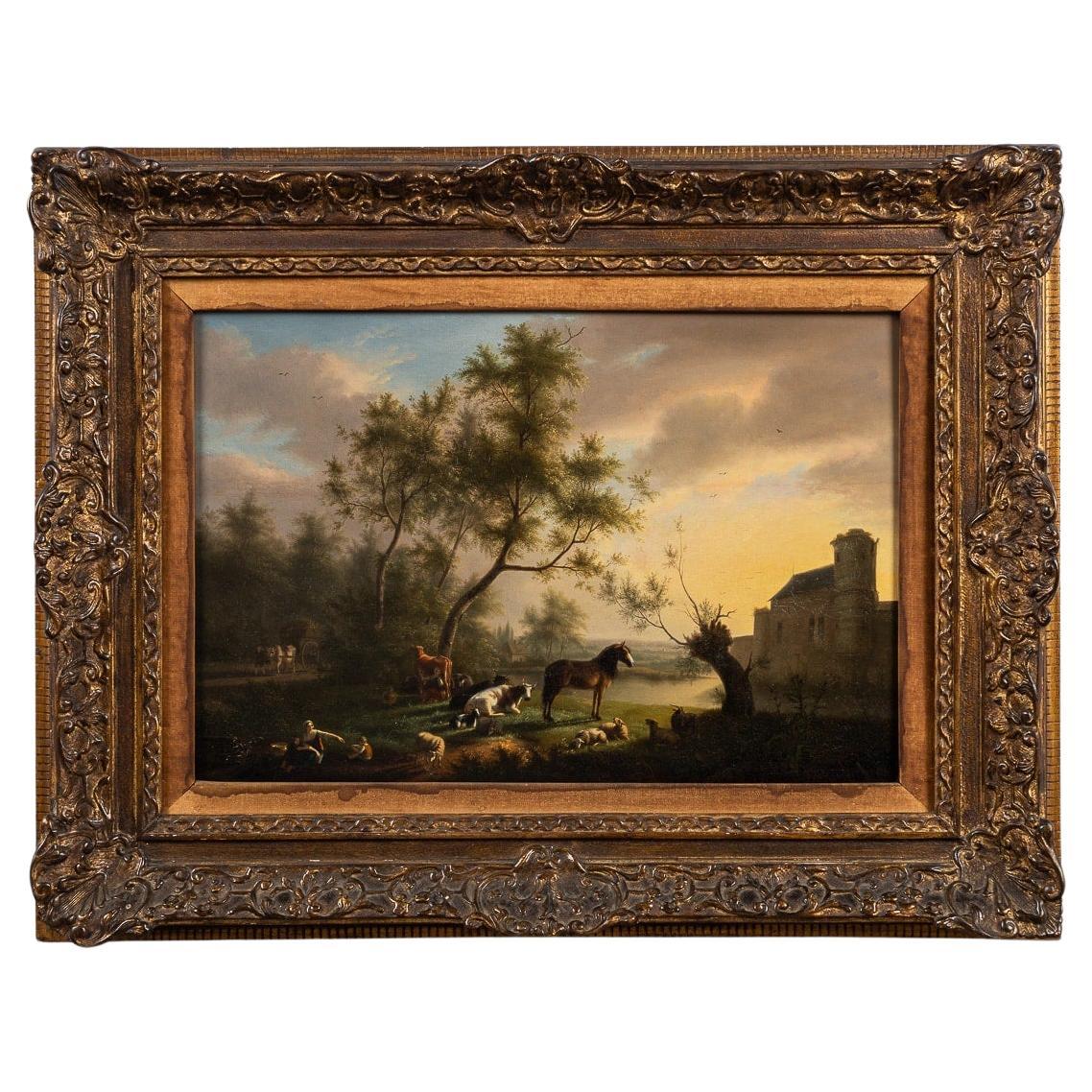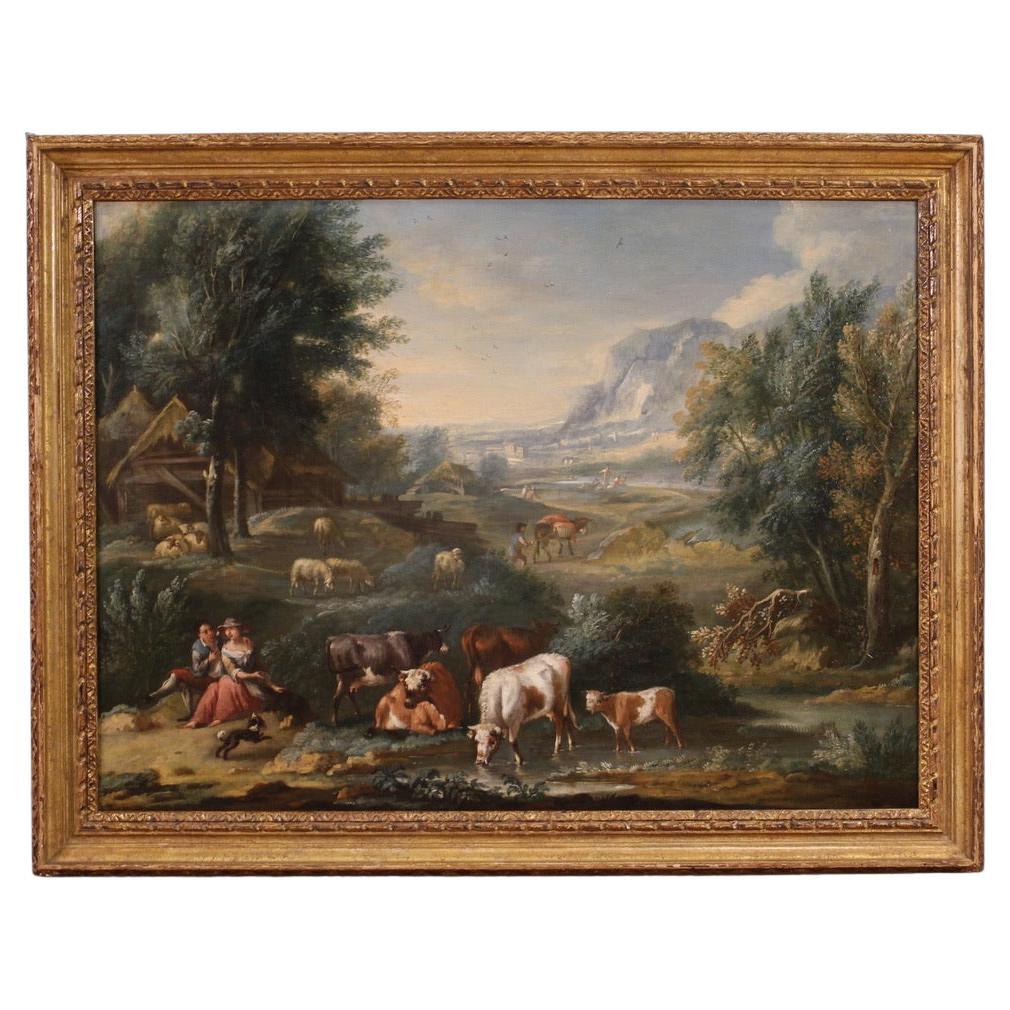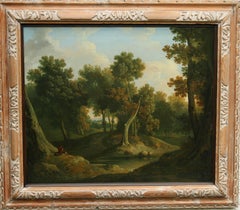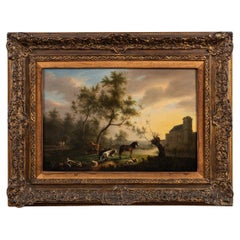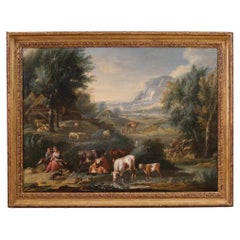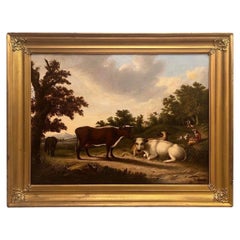Items Similar to Pastoral Landscape - British 18th century Old Master art oil painting
Want more images or videos?
Request additional images or videos from the seller
1 of 14
Philip James LoutherbourgPastoral Landscape - British 18th century Old Master art oil painting1778
1778
$13,153.60
$16,44220% Off
£9,600
£12,00020% Off
€11,197.88
€13,997.3520% Off
CA$18,017.14
CA$22,521.4320% Off
A$20,039
A$25,048.7520% Off
CHF 10,463.74
CHF 13,079.6820% Off
MX$243,853.27
MX$304,816.5920% Off
NOK 133,637.94
NOK 167,047.4320% Off
SEK 125,328.81
SEK 156,661.0220% Off
DKK 83,574.09
DKK 104,467.6220% Off
Shipping
Retrieving quote...The 1stDibs Promise:
Authenticity Guarantee,
Money-Back Guarantee,
24-Hour Cancellation
About the Item
This superb Old Master 18th century figurative landscape oil painting is by noted French born artist Philip James Loutherbourg. who settled in England in 1771. The painting has good provenance including possibly being exhibited at the Royal Academy London in 1778 so painted around that date. It was entitled A Summer's Evening with Ruins, Figures and Cattle which very aptly describes the painting. It is a large composition of an Italiante pastoral landscape. In the foreground a drover riding a horse steers his cattle over a bridge by a stream. A woman and child are on the rocks to the left. Beyond are some ruins amongst tress and the landscape stretches away in the background. It is a lovely painting with some fantastic detail and colouring. This is a superb example of an 18th century landscape by a well respected and prolific artist who was a member of the Royal Academy and exhibited there numerous times through his career.
Signed lower left on rocks.
Provenance: Dr. and Mrs Parsons of St. John’s Wood, according to label verso; W. A. Foyle; Christopher Foyle, Beeleigh Abbey.
Possibly exhibited at Royal Academy, 1778 no.195 entitled A Summer's Evening with Ruins, Figures and Cattle.
Condition. Oil on canvas, 35 inches by 23 inches and in good condition.
Frame. Housed in a carved original gilt frame, 43 inches by 31 inches and in good condition.
Philip James de Loutherbourg RA (31 October 1740 – 11 March 1812), whose name is sometimes given in the French form of Philippe-Jacques, the German form of Philipp Jakob, or with the English-language epithet of the Younger, was a French-born British painter who became known for his large naval works, his elaborate set designs for London theatres, and his invention of a mechanical theatre called the "Eidophusikon". He also had an interest in faith-healing and the occult, and was a companion of the confidence-trickster Alessandro Cagliostro. Loutherbourg was born in Strasbourg in 1740, the son of an expatriate Polish miniature painter. Intended for the Lutheran ministry, he was educated at the University of Strasbourg. Rejecting a religious calling, Loutherbourg decided to become a painter, and in 1755 placed himself under Charles-André van Loo in Paris, and later under Francesco Giuseppe Casanova. His talent developed rapidly, and he became a figure in the fashionable society of the day. In 1767 he was elected to the French Academy, although below the age required by the rules of the institution, and painted landscapes, sea storms, and battles, all of which work had a celebrity above those of the specialists then working in Paris. He made his debut with the exhibition of twelve pictures, including Storm at Sunset, Night, and Morning after Rain. Loutherbourg then travelled through Switzerland, Germany and Italy, distinguishing himself as much by his mechanical inventions as by his painting. One of these, showing new effects produced in a model theatre, was the wonder of the day, with its use of lights behind canvas representing the moon and stars, and the illusory appearance of running water produced by clear blue sheets of metal and gauze, with loose threads of silver. In 1771 he settled in London, where David Garrick paid him £500 a year to design scenery and costumes and oversee the stage machinery at the Drury Lane Theatre. His stage effects attracted the admiration not just of the general public, but also of artists, including Joshua Reynolds. He devised scenic effects in which, for instance, green trees gradually became russet and the moon rose and lit the edges of passing clouds: illusions achieved through the use of coloured lantern-slides and the ingenious lighting of transparencies. He continued to work at the theatre until 1785. Despite these other projects, Loutherbourg still found time for painting. Lord Howe's action, or the Glorious First of June (exhibited 1795) and other large naval pictures were commissioned to commemorate British naval victories, many of them ending up soon afterwards in the Greenwich Hospital Gallery (in whose successor, the National Maritime Museum, they still remain). His finest work was the Destruction of the Armada. He also painted the Great Fire of London and several historical works, including the Attack of the Combined Armies on Valenciennes (1793). He was interested in the Industrial Revolution, and his 1801 painting Coalbrookdale by Night shows iron foundries at work. Seven of his paintings, including Lodore Waterfall and Skating in Hyde Park, are in the Government Art Collection. He was made a member of the Royal Academy in 1781. Two sets of drawings by de Loutherbourg were published, reproduced in aquatint, under the titlePicturesque English Scenery in 1801 and 1805. He also contributed illustrations to a Bible published by Thomas Macklin in 1800. After his death Cadell and Davies published a volume of the Apocrypha. All 110 of his drawings for the vignettes (but not the Apocrypha) are pasted in the Bowyer Bible in Bolton Museum in Greater Manchester. There are paintings by him in the collections of many British institutions including Tate Britain, the Victoria and Albert Museum, the National Portrait Gallery, the Royal Academy of Art, Leicester, Farnham and Derby Art Gallery. Loutherbourg died in Chiswick in west London in 1812 and was buried in Chiswick Old Cemetery, adjoining the graveyard of St Nicholas Church, Chiswick. Buried nearby are the artists William Hogarth and James Abbott McNeill Whistler.
- Creator:Philip James Loutherbourg
- Creation Year:1778
- Dimensions:Height: 31 in (78.74 cm)Width: 43 in (109.22 cm)Depth: 2 in (5.08 cm)
- Medium:
- Movement & Style:
- Period:1770-1779
- Condition:
- Gallery Location:London, GB
- Reference Number:1stDibs: LU853114868952
About the Seller
5.0
Platinum Seller
Premium sellers with a 4.7+ rating and 24-hour response times
1stDibs seller since 2018
453 sales on 1stDibs
Typical response time: 1 hour
- ShippingRetrieving quote...Shipping from: London, United Kingdom
- Return Policy
Authenticity Guarantee
In the unlikely event there’s an issue with an item’s authenticity, contact us within 1 year for a full refund. DetailsMoney-Back Guarantee
If your item is not as described, is damaged in transit, or does not arrive, contact us within 7 days for a full refund. Details24-Hour Cancellation
You have a 24-hour grace period in which to reconsider your purchase, with no questions asked.Vetted Professional Sellers
Our world-class sellers must adhere to strict standards for service and quality, maintaining the integrity of our listings.Price-Match Guarantee
If you find that a seller listed the same item for a lower price elsewhere, we’ll match it.Trusted Global Delivery
Our best-in-class carrier network provides specialized shipping options worldwide, including custom delivery.More From This Seller
View AllCattle and Drover in a Landscape - British Victorian art landscape oil painting
Located in London, GB
This gorgeous oil on canvas Victorian Old Master painting is by British artist Henry Jutsum. Painted circa 1850 the painting depicts a drover on horse back bringing up the rear behin...
Category
19th Century Old Masters Landscape Paintings
Materials
Oil
Landscape with Ruins and Figures - British 18thC Old Master art oil painting
By Richard Wilson
Located in London, GB
This superb British 18th century Old Master oil painting is attributed to circle of noted landscape artist Richard Wilson. Painted circa 1750 it is a stunning light, bright and airy expansive panoramic landscape. There is a river in the foreground and mountains in the background. On the left of the river stands some ruins and on the right, figures are resting under the trees. The palette of blues, greens and very varied and rich with some lovely pinky brown tones for the land on the right. The brushwork is also delicate but confidently executed. A superb example of a British Old Master landscape oil painting, finished off in a carved and gilt wood English Rococo frame with name plate.
Provenance. The Asbjorn Lunde Foundation, Inc. Throughout his long life, Mr. Lunde supported more than forty museums in his native New York, across the United States, and in Europe with loans, gifts, and funding. Mr. Lunde was a proud New Yorker with roots in Norway. He was keenly interested in nineteenth-century Scandinavian and Swiss landscape painting, Old Master painting, and Asian decorative arts.
According to an old label to the reverse, the present painting was once owned by James Northcote (1746-1831) who gave it to William Hillman on 25th May 183(0?)
Property of the Bacot family.
Christies stamps verso.
Watson Gallery London. Remains of label verso.
Condition. Oil on canvas, 26 inches by 18 inches and in good condition.
Frame. Housed In a carved and gilt wood English Rococo frame bearing Richard Wilson name plate, 33 inches by 25 inches and in good condition.
Richard Wilson RA...
Category
1750s Old Masters Landscape Paintings
Materials
Oil
$24,114 Sale Price
20% Off
Classical Landscape - French 17th century art Old Master oil painting
By Jean François Millet
Located in London, GB
This superb 17th century French Old Master oil painting is attributed to Jean Francois Millet. Painted circa 1670 it is a classical landscape with figures by a bend in a river in the...
Category
17th Century Old Masters Landscape Paintings
Materials
Oil
$19,730 Sale Price
20% Off
Old Master Wooded Landscape - Irish 1830 art woodland oil painting
By James Arthur O'Connor
Located in London, GB
A delightful large oil on canvas of a wooded landscape which dates to circa 1830 and is attributed to Irish artist James Arthur O’Connor. A superb painting and an excellent example o...
Category
18th Century Old Masters Landscape Paintings
Materials
Oil
$43,845 Sale Price
20% Off
Shepherd with Animals in Landscape - Dutch Old Master art pastoral oil painting
By Nicolaes Berchem
Located in London, GB
This lovely Dutch Old Master oil painting is attributed to noted Dutch artist Nicholaes Berchem. Painted circa 1665 it is a charming pastoral scene of a shepherd and his animals including sheep, goats, donkey and cows and of course his trusty dog. They are all resting beneath trees while he looks on attentively. The light in the sky and the light and shadows on the animals is beautiful. A really superb example of Dutch Old Master art with great detail.
Provenance. Surrey estate.
Christies stamp verso.
Condition. Oil on canvas, 38 inches by 32 inches and in good condition.
Frame. Housed in a complementary gilt frame, 46 inches by 30 inches and in good condition.
Nicolaes Pieterszoon Berchem (1620-1683) was a highly esteemed and prolific Dutch Golden Age painter of pastoral landscapes, populated with mythological or biblical figures, but also of a number of allegories and genre pieces. He was a member of the second generation of "Dutch Italianate landscape" painters. These were artists who travelled to Italy, or aspired to, in order to soak up the romanticism of the country, bringing home sketchbooks full of drawings of classical ruins and pastoral imagery. His paintings, of which he produced an immense number, (Hofstede de Groot claimed around 850, although many are misattributed), were in great demand, as were his 80 etchings and 500 drawings. His landscapes, painted in the Italian style of idealized rural scenes, with hills, mountains, cliffs and trees in a golden dawn are sought after. Berchem also painted inspired and attractive human and animal figures (staffage) in works of other artists, like Allaert van Everdingen, Jan Hackaert, Gerrit Dou, Meindert Hobbema and Willem Schellinks. Born in Haarlem, he received instruction from his father Pieter Claesz, and from the painters Jan van Goyen, Pieter de Grebber, Jan Baptist Weenix, Jan Wils and Claes Cornelisz. Moeyaert. According to Houbraken, Carel de Moor told him that Berchem got his name from two words "Berg hem" for "Save him!", an expression used by his fellows in Van Goyen's workshop whenever his father chased him there with the intent to beat him. No trip or Grand Tour by Berchem was documented by Houbraken though he mentioned another story about the "Berg hem!" nickname which came from Berchem's conscription as a sailor; the man in charge of impressment knew him and sent him ashore with the words "Save him!". Today his name is assumed to come from his father's hometown of Berchem, Antwerp. According to the RKD he traveled to Italy with Jan Baptist Weenix, whom he called his cousin, in 1642–5. Works by him are signed both as "CBerghem" and "Berchem". In 1645 he became a member of the Dutch reformed church and married the year after. According to Houbraken he married the daughter of the painter Jan Wils, who kept him on a short allowance, but to finance his collection of prints he would borrow money from his pupils and colleagues and pay them back from the proceeds of paintings that he didn't tell her about. Around 1650 he travelled to Westphalia with Jacob van Ruisdael, where a dated piece showing Burg Bentheim is recorded. Maybe Berchem went to Italy after this trip and before he moved to Amsterdam - he is not clearly documented in the Netherlands between 1650 and 1656. Around 1660 he worked for the engraver Jan de Visscher designing an atlas. In 1661-1670 he is registered in Amsterdam and in 1670 he moved back to Haarlem, but was living back in Amsterdam by 1677, where he died in 1683. He was a popular teacher and his pupils were Abraham Begeyn, Johannes van der Bent, his son Nicolaes, Isaack Croonenbergh, Simon Dubois, Karel Dujardin, Johannes Glauber, Pieter de Hooch, Jacob van Huchtenburg, Justus van Huysum...
Category
17th Century Old Masters Landscape Paintings
Materials
Oil
$15,345 Sale Price
20% Off
Pastoral Scene with Shepherd and Animals - Old Master c 1700 art oil painting
By Philipp Peter Roos (Rosa di Tivoli)
Located in London, GB
This superb Old Master later 17th/early 18th century oil painting is attributed to Baroque painter and German born animal artist Philipp Peter Roos. He was active in and near Rome fr...
Category
Early 1700s Old Masters Animal Paintings
Materials
Oil
$8,769 Sale Price
20% Off
You May Also Like
Antique 19th Century Oil On Panel Pastoral Setting, Martin Verstappen 1773-1852
Located in Royal Tunbridge Wells, Kent
An exceptional 19th-century depiction of a pastoral setting by the hand of Martin Verstappen. The foreground features a mother with her two children, nestled amidst lush tall grass. ...
Category
Antique 19th Century European Other Paintings
Materials
Giltwood, Paint
18th Century Oil on Canvas Italian Bucolic Landscape Painting, 1770
Located in Vicoforte, Piedmont
Venetian school of the second half of the 18th century. Oil painting on canvas depicting an Arcadian landscape of pastoral genre. This type of pictorial representation established it...
Category
Antique 1770s Italian Paintings
Materials
Canvas
Landscape Zuccarelli Paint Oil on canvas Old master 18th Century Italian View
By Francesco Zuccarelli (Pitigliano 1702 - Florence 1788)
Located in Riva del Garda, IT
Francesco Zuccarelli (Pitigliano 1702 - Florence 1788), circle of
Landscape with river and resting shepherds
First half of the 18th century
oil painting on canvas
cm. 60 x 93, within a carved and gilded wooden frame cm. 75 x 108
This delightful landscape view animated by a family of shepherds who rest from their daily duties should be compared to the hand of Francesco Zuccarelli (Pitigliano 1702 - Florence 1788);
In the landscapes painted by Zuccarelli the world is crystallized, frozen in a moment of idyllic quiet,
where the 'Arcadian' sense of the landscape is rendered with that pictorial vivacity, chromatic lightness and compositional grace that we find in its entirety in his painting.
By way of comparison we can compare our canvas to other compositions, including:
- Landscape with river and resting shepherds, Accademia Carrara, Bergamo
- Landscape with bridge and horseman, Accademia Carrara, Bergamo
- Landscape with river, village, fisherman and shepherdesses' (Christie's, London May 1960,
- Landscape with figures, Accademia Carrara,
- Landscape with knight and figures, Accademia Carrara
Tuscan by origin, Francesco Zuccarelli trained first in Florence with the landscape architect Paolo Anesi...
Category
18th Century Old Masters Paintings
Materials
Oil
$6,495 Sale Price
40% Off
Large Scale 19th Century English School Bucolic Landscape Oil Painting
Located in Atlanta, GA
Exceptional Large Scale 19th Century English School Bucolic Landscape Oil Painting. While there is no signature or specific attribution to the artist’s hand - it is with a doubt an e...
Category
Antique 19th Century Paintings
Materials
Canvas, Giltwood, Paint
$7,160 Sale Price
20% Off
17th Century by Pietro Montanini Landscape Oil on Canvas
Located in Milano, Lombardia
PIETRO MONTANINI (Perugia, Italy, 1619 - 1689)
Title: Landscape
Medium: Oil on canvas
Dimensions: without frame 50 x 65 cm - with frame 64 x 79 cm
An...
Category
17th Century Old Masters Landscape Paintings
Materials
Canvas, Cotton Canvas, Oil
Antique Italian painter - 18th century landscape painting - Sheperds
Located in Varmo, IT
Italian painter (18th century) - Landscape with shepherds at rest.
44 x 61 cm.
Antique oil painting on canvas, without frame (not signed).
Condition report: Lined canvas. Good con...
Category
Early 18th Century Rococo Landscape Paintings
Materials
Canvas, Oil
$958 Sale Price
68% Off
More Ways To Browse
Old Wood Art
18th Century English Painting
French Pastoral
18th Century French Landscape
18th French Oil Painting
English Painting Child
Antique Inventions
Antique Battle Painting
18th Century British Paintings
Antique Machinery
Battle Of Britain
18th Century Costume
Dior Miniatures
Used Stage Lights
Foundry Painting
18th Century Pastoral
John Andre
Oil Painting 1800

